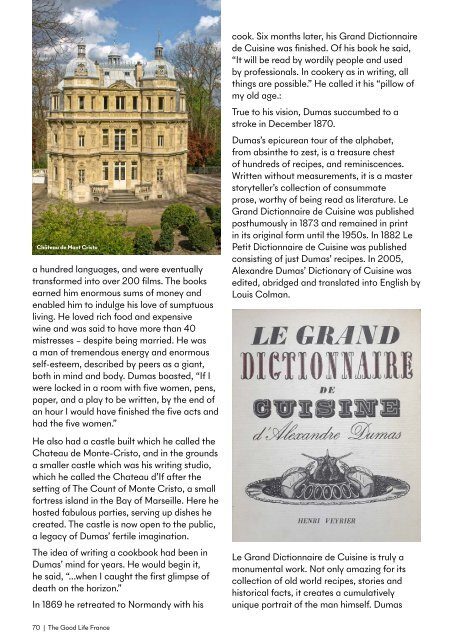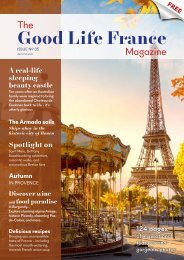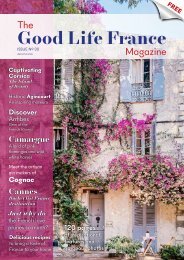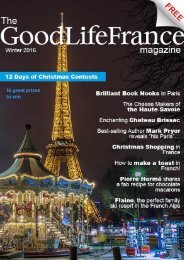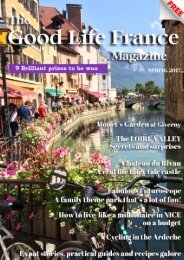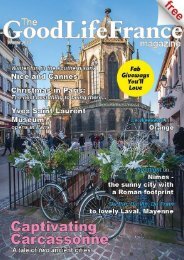Autumn 2022
Discover Aix, the ‘Little Paris’ of Provence, the historic region of Beaune, a land of wine and castles. Beautiful Bordeaux and Normandy. The stork villages of Alsace and the pickled-in-the-past, post-card pretty perched town of Saint-Guilhem-le-Desert. Breath-taking Lavender fields in Provence, castles in the air in Dordogne. Exquisite Villefranche-sur-Mer and Nice. Discover what’s new, the best tours, recipes, a language lesson, practical guides and much, much more…
Discover Aix, the ‘Little Paris’ of Provence, the historic region of Beaune, a land of wine and castles. Beautiful Bordeaux and Normandy. The stork villages of Alsace and the pickled-in-the-past, post-card pretty perched town of Saint-Guilhem-le-Desert. Breath-taking Lavender fields in Provence, castles in the air in Dordogne. Exquisite Villefranche-sur-Mer and Nice. Discover what’s new, the best tours, recipes, a language lesson, practical guides and much, much more…
- No tags were found...
You also want an ePaper? Increase the reach of your titles
YUMPU automatically turns print PDFs into web optimized ePapers that Google loves.
Château de Mont Cristo<br />
a hundred languages, and were eventually<br />
transformed into over 200 films. The books<br />
earned him enormous sums of money and<br />
enabled him to indulge his love of sumptuous<br />
living. He loved rich food and expensive<br />
wine and was said to have more than 40<br />
mistresses – despite being married. He was<br />
a man of tremendous energy and enormous<br />
self-esteem, described by peers as a giant,<br />
both in mind and body. Dumas boasted, “If I<br />
were locked in a room with five women, pens,<br />
paper, and a play to be written, by the end of<br />
an hour I would have finished the five acts and<br />
had the five women.”<br />
He also had a castle built which he called the<br />
Chateau de Monte-Cristo, and in the grounds<br />
a smaller castle which was his writing studio,<br />
which he called the Chateau d’If after the<br />
setting of The Count of Monte Cristo, a small<br />
fortress island in the Bay of Marseille. Here he<br />
hosted fabulous parties, serving up dishes he<br />
created. The castle is now open to the public,<br />
a legacy of Dumas’ fertile imagination.<br />
The idea of writing a cookbook had been in<br />
Dumas’ mind for years. He would begin it,<br />
he said, “…when I caught the first glimpse of<br />
death on the horizon.”<br />
In 1869 he retreated to Normandy with his<br />
cook. Six months later, his Grand Dictionnaire<br />
de Cuisine was finished. Of his book he said,<br />
“It will be read by wordily people and used<br />
by professionals. In cookery as in writing, all<br />
things are possible.” He called it his “pillow of<br />
my old age.:<br />
True to his vision, Dumas succumbed to a<br />
stroke in December 1870.<br />
Dumas’s epicurean tour of the alphabet,<br />
from absinthe to zest, is a treasure chest<br />
of hundreds of recipes, and reminiscences.<br />
Written without measurements, it is a master<br />
storyteller’s collection of consummate<br />
prose, worthy of being read as literature. Le<br />
Grand Dictionnaire de Cuisine was published<br />
posthumously in 1873 and remained in print<br />
in its original form until the 1950s. In 1882 Le<br />
Petit Dictionnaire de Cuisine was published<br />
consisting of just Dumas’ recipes. In 2005,<br />
Alexandre Dumas’ Dictionary of Cuisine was<br />
edited, abridged and translated into English by<br />
Louis Colman.<br />
Le Grand Dictionnaire de Cuisine is truly a<br />
monumental work. Not only amazing for its<br />
collection of old world recipes, stories and<br />
historical facts, it creates a cumulatively<br />
unique portrait of the man himself. Dumas<br />
avowed he would not eat pâté de foie gras<br />
because the ducks and geese “…are submitted<br />
to unheard of tortures worse than those<br />
suffered under the early Christians.”<br />
And his description of the perfect number<br />
of dinner guests within the parentheses<br />
of ancient history still holds true today: “…<br />
Varro, the learned librarian, tells us that the<br />
number of guests at a Roman dinner was<br />
ordinarily three or nine — as many as the<br />
Graces, no more than the Muses. Among the<br />
Greeks, there were sometimes seven diners,<br />
in honour of Pallas. The sterile number seven<br />
was consecrated to the goddess of wisdom,<br />
as a symbol of her virginity. But the Greeks<br />
especially liked the number six, because it<br />
is round. Plato favoured the number 28, in<br />
honour of Phoebe, who runs her course in 28<br />
days. The Emperor Verus wanted 12 guests<br />
at his table in honour of Jupiter, which takes<br />
12 years to revolve around the sun. Augustus,<br />
under whose reign women began to take their<br />
place in Roman society, habitually had 12 men<br />
https://frenchcountryadventures.com/<br />
Dumas had a metro station on line 2 named after him in 1970. There is also a<br />
Rue Alexandre-Dumas in Paris<br />
and 12 women, in honour of the 12 gods and<br />
goddesses. In France, any number except 13<br />
is good.”<br />
For Dumas a perfect dinner is also “a major<br />
daily activity which can be accomplished in<br />
worthy fashion only by intelligent people. It<br />
is not enough to eat. To dine, there must be<br />
diversified conversation which should sparkle<br />
with rubies of wine between courses, be<br />
deliciously suave with the sweetness of dessert<br />
and acquire true profundity by the time coffee<br />
is served.”<br />
70 | The Good Life France The Good Life France | 71


